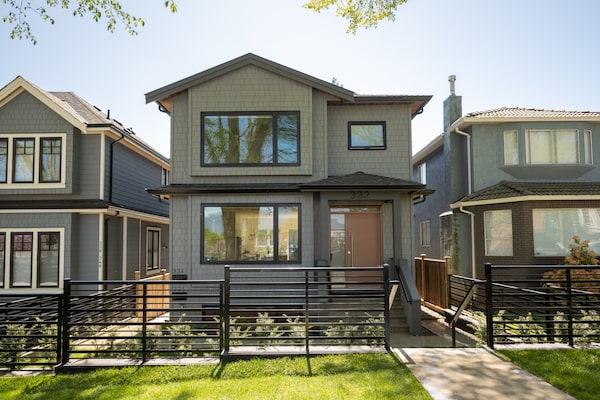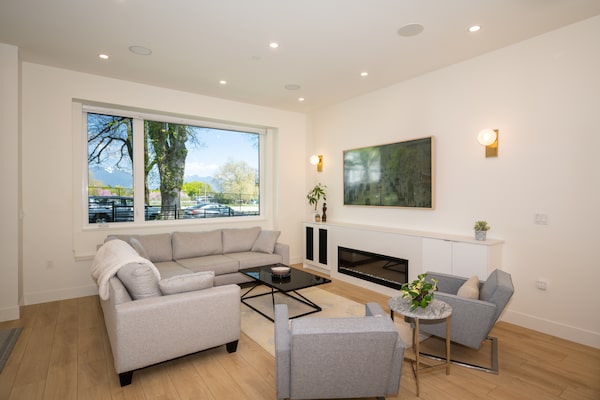
Handout
Realtor Danny Nikas thought that they might be pushing it, listing an east side property on a 33-foot-lot for almost $3.6-million. But the seller, who’s experienced in real estate, insisted on the price. They ended up setting a Vancouver record.
The seller had purchased an old house at 332 E. 23rd Ave., on the east side of Main, and in 2020, built a new 2,900 square-foot home with laneway house. Although it’s only a standard 33- by-122-foot-lot without much in the way of yard space or landscaping, and some mountain views, the seller knew that there was a market for it.
The seller insisted that they wait two weeks to look at offers. After two weeks on the market, the property sold Monday night for $4-million – the highest price paid for a house on a 33-foot-lot on Vancouver’s east side, says Mr. Nikas.

The sale sets a record as the highest sale price of a 33-foot property on the east side.Handout
They received three offers, all over the asking price of $3.588-million. One offer was slightly higher than $4-million.
“I had so many calls the next two days from realtors, calling and saying, ‘I heard a rumour, is this true? Four million dollars?’ One realtor said, ‘that’s a record that will never get broken.’ It will get broken – eventually.”
All the offers came from millennial age buyers with young kids. All offers were subject free and were made with a bank draft deposit. The winning offer came from Canadians who’d been working in Seattle and sold a house there, and that gave them the edge, says Mr. Nikas. Mr. Nikas felt that the couple with the American money would be less risky.
Developer files lawsuit against Vancouver over empty-homes tax
“Four million to them is kind of like $3-million, if you know what I mean. Whereas I’m worried that if we go with the other offer, I’m worried that in a month a bank might do an appraisal and if comes in at $3.6-million there will be a $400,000 shortfall and will they be able to complete in August?”
Mr. Nikas says the market is changing, and for those who are borrowing, there could be a risk if bank appraisals come in lower by the time they need that mortgage.
“I’ve been hearing stories,” he says. “Many homes are selling over asking, $300,000 or $500,000 over asking. A few of the higher priced homes I’ve heard, they are not appraising out at what people are buying them for. So there’s a shortfall somewhere, and it makes it challenging for someone to complete three months later. I brought that up [with the seller], that it could be a concern.”
“[But] I thought … if they sold their house in Seattle with U.S. dollars, they are buying in Canadian dollars, so they have that extra money. That was the reason I suggested we go with that offer, and they agreed.”
The sale sets a record as the highest sale price of a 33-foot property on the east side. Mr. Nikas had set another record last November when he sold a five-bedroom character house around the corner on a 33-foot-lot at 285 E. 24th Ave. It was listed at $2.850-million and sold for $3.3-million. That sale had attracted the attention of the seller on East 23rd Ave., who believed he could sell his new house for $4-million, despite Mr. Nikas’s doubts.

All the offers came from millennial age buyers with young kids.Handout
“He was confident, and this is why: from the beginning he told me, if you want a new house with a laneway house, there is no inventory. The cost of lumber has gone up so much for building that it’s going to cost anyone to build the same house today way more than it did two years ago. So he knew if people do their research on what it costs to buy a lot and build, $4-million is not out of line. His crystal ball was accurate.”
The seller, who declined an interview, lived in the house with his young family but decided to sell for financial reasons. BC Assessment shows that the property was sold in May 2018 for $1.7 million. As of July 2020, the home was assessed at $2.469 million.
“This was their forever home, but the dynamics had changed. He felt financially pressured with a high mortgage, and thought, ‘is it better to live in a more modest home without the pressure of a big mortgage?’”
Mr. Nikas says the plan is to buy a more modest home and use their extra money to buy a recreational property. The seller owns other properties, he said.
Mr. Nikas lives in Dunbar on the west side, but people are choosing the vibrancy of Main Street over his quiet, bucolic area.
“The Main street pocket is more vibrant, and it’s very central, whether going east, west, north or south, any direction. And Vancouver has gotten worse with traffic over years so when you are in Dunbar you are so far west it takes you so much further to get anywhere, whereas with Main Street, you are almost at the epicentre. And there are more young families, more vibrant of a community. Certain people bought in Dunbar and Point Grey in the last 10 or 15 years, and it doesn’t have a vibrant community feel; it’s very quiet. For me, I like it because at eight o’clock it’s quiet. There are no transient people looking for bottles, and it’s edgier by Commercial Drive or Main Street, in the evenings. But people do like that vibrant walkability of Main Street to get to shops and restaurants, and stuff.
The vibrancy and central location of Vancouver’s Main Street corridor surrounding Broadway is a critical factor in the area’s skyrocketing housing prices, according to the agent.JENNIFER ROBERTS/The Globe and Mail
“Right now Douglas Park and Main Street pockets are out-pricing Dunbar and Point Grey, which historically used to be the highest values.
“In Dunbar/Point Grey, new houses on 33 [foot lots] are not selling for $4-million.”
Mr. Nikas believes that low inventory and low interest rates are driving the market, as well as some buyers who are trying to buy before changes on June 1 that will make the mortgage stress test tougher.
He’s noticed that there’s increasing inventory, so it’s becoming more of a balanced market than a total seller’s market.
Realtor Patricia Houlihan, who specializes in the Northshore market, called the price “ridiculous.”
“I think the problem is, some people don’t realize how grossly they are over paying, and that’s a bit scary,” says Ms. Houlihan, who is also a lawyer.
‘Worse and worse every day’: Home builders roiled by product shortages, volatile prices
She says that the market is changing and she’s advising her clients to ask for a short closing date, and to rent back the property if necessary. If the appraisal comes in lower than the accepted price, then a buyer might have to come up with a bigger down payment. And she’s heard of buyers who put in high offers with the expectation that they can always walk away from it if they can’t get financing.
“You need it to close now. There’s a very good chance the market will significantly change in the next three to six months, so if you have a three-month closing your buyer may not be able to complete.
However, she says that there are many low-risk local buyers who are paying cash and fully prepared to go through with the sale.
“A lot of buyers are paying cash, have their financing ready to go, and have already sold, and they are no more risky than someone out of the country. When dealing with multiple offers, you’ve got to know who the buyers are and what their situation is, because the market could change on a dime.”
Realtor Cheryl Steer sold a bungalow recently at 3193 West 28th Ave., in the MacKenzie Heights neighbourhood on the west side, for $3.1-million, which was $500,000 over the asking price. The older house, which sold after seven days, sits on a large corner lot, in an area that had at one time been considered far more expensive than any part of the east side. Ms. Steer grew up in MacKenzie Heights.
“We did see the east side go up significantly in price, whereas some of the sub areas on the east side became more expensive than on the west side,” says Ms. Steer. “The Main area in particular is really hot. Anywhere on that Main corridor is just so sought after. And I can understand why – it’s because you’re close to transit and there are so many restaurants and shops, it has become a destination. In Dunbar, and along certain parts of Broadway, Fourth, and Tenth Avenue, you are seeing businesses failing all the time. And it’s further from transit, and also I feel over the past little bit, that downsizers have crept east probably because their kids are [living] out that way. There’s more action over there.
“The east side has become what the west side was when I was growing up.”
Your house is your most valuable asset. We have a weekly Real Estate newsletter to help you stay on top of news on the housing market, mortgages, the latest closings and more. Sign up today.
 Kerry Gold
Kerry Gold